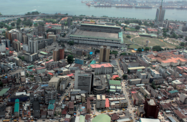The recalculation of Nigeria’s GDP may encourage more foreign investment and further development, though the rebasing process has also underscored the need for more of this newly identified wealth to be invested in structural reforms to ease income inequality and boost social and economic inclusiveness.
In early April, the government announced the results of an extended programme of research into GDP measurement, moving the base year from which the economy’s size and depth was worked out from 1990 to 2010. The shift allowed the true input of many industries that had a minor profile almost 25 years ago, or did not exist at all, to be more clearly considered in the national accounts.
In total, 46 separate economic activities were assessed under the rebasing process, compared to just 33 in the 1990. As a result, Nigeria’s GDP jumped from an initial estimate of $285.5bn to $510bn in 2013, pushing it well past the traditional regional leader South Africa, which posted a GDP of $370bn last year.
It was not just the estimated size of the economy that was altered by the rebasing; so too was the understanding of the roles of various sectors. Data from the state statistics bureau showed that input from agriculture, the country’s largest employer, fell from 30% to just under 24%, while the slide for industry was even greater, dropping from 46% to 25.8%. The biggest mover, however, was the services sector – which included fields such as telecoms, retail and media, all of which were underrepresented under the previous base year – which more than doubled from the pre-recalibration rate of 23% to more than 50%.
The rebasing sees Nigeria’s credit ratios strengthen markedly, with its already low debt to GDP level declining from 19% to 11%, while the country’s interest payments as a proportion of national product also fell. By contrast, the rebasing does mean that foreign currency reserves as a percentage of GDP have fallen, though dips in oil revenue due to dropping production and exports have had a more tangible impact on reserve levels.
Potential boost for investment
The World Bank, which assisted Nigeria in calculating its new GDP results, said that the rebasing process was an important step forward in improving the understanding of the size and structure of the Nigerian economy. According to Francisco Ferreira, the World Bank’s chief economist for the African region, the rebasing would both help identify sectors that were in need of more support and serve as an advertisement to international investors. “Nigeria’s GDP, which placed the country as Africa’s largest economy, has exposed its investment potential to the world,” he said.
The ratings agency Moody’s also responded positively to the rebasing results, issuing a statement following the release of the new data that the measure supported an accurate assessment of Nigeria’s economic standing and its sovereign credit profile. Importantly for both local and international investors, Moody’s has predicted the jump in Nigeria’s GDP will pale in comparison to the growth surge expected over the coming three decades and more.
“Nigeria is likely to number among the world’s 15 largest economies by 2050, when GDP is projected to exceed $4.5trn in purchasing power parity terms,” said Aurelien Mali, a vice-president and senior analyst with the agency.
This almost nine-fold increase in the size of the economy and a rise to 15th place globally, if achieved as forecast by Moody’s, would represent both one of the greatest climbs up international economic ladder for many years, and a massive investment opportunity as the country moved from a commodities-based economy to a more diverse platform.
Regional rivalry
Of course, Nigeria is not the only African market seeing dramatic changes in its development trajectory. Other West African states such as Côte d’Ivoire are posting equally strong GDP growth rates while Ghana also recently underwent a re-basing process that pushed the country to lower middle-income status.
The leapfrogging of South Africa is equally impressive, although it comes with caveats, including the fact that per capita income in South Africa, for example, remains well above that of Nigeria. South Africa also produces roughly 10 times the amount of electricity as Nigeria, in spite of having a population roughly one-third the size, and has a lower informal sector.
Similarly, while Nigeria may see its GDP rise by a factor of nine by 2050, its population will more than double in that time, hitting 440m, according to UN estimates, placing far greater pressure on social and economic infrastructure. However, with greater transparency and clarity in terms of its economy, Nigeria should be able to better mobilise the funds to bridge the gaps in its national infrastructure grid, creating employment and higher levels of income parity along the way and keeping it in front of its regional rivals.
Follow Oxford Business Group on Facebook, Google+ and Twitter for all the latest Economic News Updates. Or register to receive updates via email.

